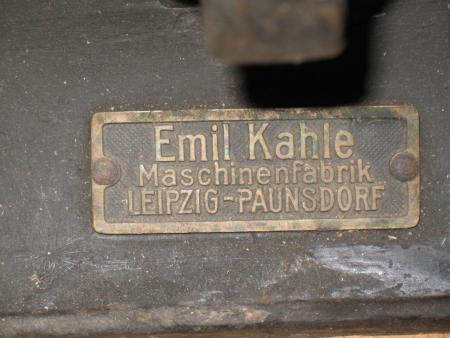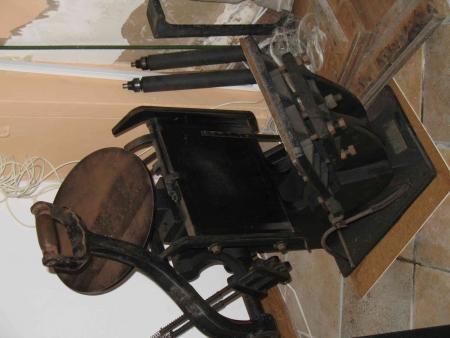Table top platen press - Emil Kahle - Chase size
Good evening everybody,
I have purchased a press manufactured decades ago in Germany by the Emil Kahle company. I am giving it a good cleaning.
However the chase was missing. Its dimensions -estimated - are 8-1/2” x 12-1/2”. I think I have got no choice but design one and have it machined from thick sheet metal. Has somebody an idea how deep it should be : 3/4”, 5/6”..?
Well, if somebody owns an Emil Kahle press, I would be happy to hear from him/her.
I attach a couple of pictures of the beast.
Regards from France,
Sébastien

The press was sleeping in a garage...

Manufacturer plate

Missing chase
To get a metal chase made might be expensive, you can make one out of plywood, they work really well, check the archives on this site, you will find information on this. Good Luck Dick G.
Metal chases were either cast or made from welded steel bar, not machined from a solid piece of steel. If you can find proper dimensions for a chase that belongs to the press, a machinist would be able to duplicate it. I have several chases that are welded, and they are superior to anything else.
Paul
Hello Sebastien,
Machining is costly, but for the rare press needing parts, you might be willing to pay it.
I have a rather uncommon press in my collection, which came with a warped and cracked chase which I used for a few months until it broke during a lockup. Examination of the broken chase revealed rust and long standing cracks, indicating it was only a matter of time.
I did specifications/drawings of exactly what I wanted milled, and had a chase machined from 5/8” plate steel. Cost, $400 for 1 chase. I do not regret it as the press is sufficiently uncommon and of sufficient value to make a $400 investment to keep it running worth it to me. But then, it is less a business decision than an emotional one for this press. I would not have paid that to have a C&P 10x15 chase made since they are readily available in the secondary market.
Having one welded from 5/8”square rod stock would have been cheaper, probably in the $150 range. If I were having one welded, I might go with 5/8 x 3/4 rectangular rod stock depending on the total size of the chase for added strength. For an 8x12 outside dimension chase, I’d go with the heavier rod stock.
Best bet is to make the drawings, take them to a competent machinist, and ask for a bid. Then take a similar drawing to a fabricator/welder and asking for a bid as well. The reality is a machined chase will be superior in strength although that is largely theoretical at the pressures we’re talking about in a typical lockup for a small press.
Best,
Alan
This press looks like its mechanism is based on the venerable Golding Official, and the chase size sounds similar too. If it is, an Official chase might be modified to fit at less cost and more satisfaction than making one, though finding a Golding chase in Europe might be challenging.
To get the chase outside dimensions, measure from the inside of the catches at the bottom left and right of the bed to the top edge of the bed, and between the rails. The inside dimensions are not critical, but the outside ones are.
Bob
Salut Sébastien, have a look at the picture of the chase of my German press. It would be useful to have dimensions in millimetres. If you want more photos, e-mail me, I’m Paris based.
german_press_chase_2.jpg
If you can find an old chase of the right thickness, it would be much cheaper to cut it down to size and have the two corners rewelded.
Better than trying to match measurements, I recommend creating - and fitting - a wooden template as a master pattern. Make one of wood - just to get the dimensions and fit just right. Then give that pattern to a machinist for manufacture.
I have some chases that were made of bar steel, cut with overlaps on the corners and held in place with pins applied vertically to make tight fit. They seem to be the most easy to duplicate at far lower cost than casting or machining from a large block of steel.
But as Dick suggests, chases made of wood will work as well. We have an 8x12 C&P chase that Rich Polinski made from a large piece of 3/4” plywood. The walls are 2” thick, but even a 1” wall should do for a press such as this.
We have had chases cast in iron for smaller Kelsey, Victor and other presses we have restored. And, although they work fine, they are prohibitively expensive to manufacture and stock for resale.
If your interest is printing with photo-polymer plates, we could fashion one of our chase-bases to fit your press, but would need the outside dimensions and notes about any oddities of the outside fit and your particular press’ chase latching mechanism.
Hello and thanks to each of you for your contribution !
I’ll probably go for the solution indicated by Alan Runtfeld : square bars - with overlaps - affixed together with spring pins.
There are skilled welders in my company, and I work closely with machining shops, so I might try several solutions. A plywood prototype is a very good idea.
I will keep you informed.
Thank you again for the quick responses !
Regards,
Sébastien
Hi Sébastien,
I think that the extra step of making a wooden pattern would only benefit you if you are planning to have it cast. Machinists have the tooling to make what you want, exactly as per specifications. An electrically welded chase is stronger than a lapped and pinned chase, as the welds themselves are stronger than the steel. A lapped and pinned set-up is not as strong as a single weld. The chase must be perfectly square, which means the work has to be appropriately clamped during welding. It is really much simpler than Alan is suggesting.
Paul
Are you still looking for information for this machine? I have an identical one which I have restored recently and would be happy to share info on it.
warm regards from Cyprus